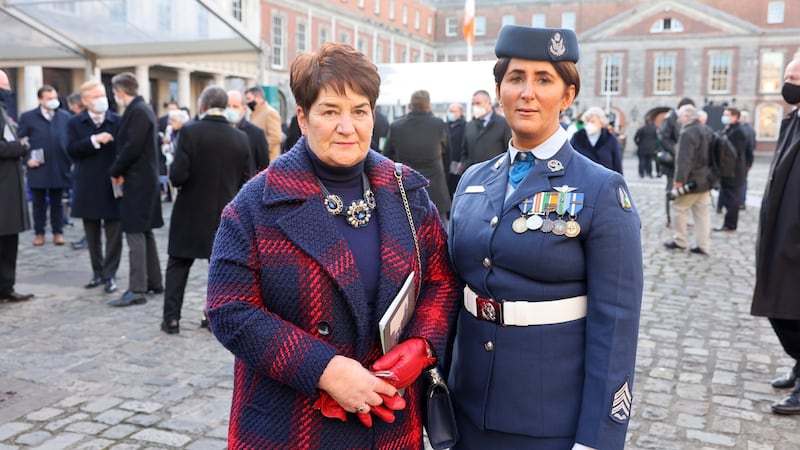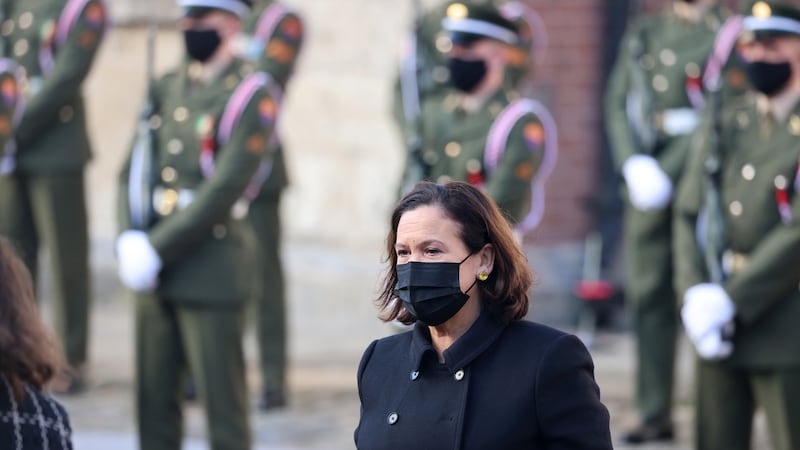It began in 1922 with a simple handover of power from the British to most of the Irish.
But many decades along the way, with the new nation modernising and monetising, Dublin Castle became less known as the home of the historic handover and increasingly notorious as a home from home for hand-over-fist merchants.
After 70 years a-growing, the hot news from the upper and lower yards went from accounts of a low-key transfer of power to lurid reports of the abuse of that power. The castle became a place where successive tribunals explored how money went into brown envelopes and secret bank accounts.
So while the old walls witnessed many more powerful men traversing those ancient cobbles, their motives were not exactly in the Michael Collins category of state service.
Dignity and honour reasserted itself on Sunday for a State commemoration of that historic handover of power, the ceremony taking place beneath the room where it happened exactly 100 years ago.
As the historians have been pointing out for the past week, the event was a brief and somewhat rushed affair, with the British keen to get the formal process over as quickly and quietly as possible and the Irish side in a hurry to get back to the Mansion House, where the provisional government was meeting.
The ceremony in the courtyard a century later kept to the same short, early afternoon timetable while the tone of the proceedings echoed the deliberately low-key nature of one of the most significant events in Irish history. But where Michael Collins and his fellow ministers were driven through cheering crowds as they approached the castle gates, the turnout on this occasion was sparse.
There were no flags flying at the castle when the last lord lieutenant of Ireland, Viscount FitzAlan of Derwent, formally handed over Dublin Castle and the power that went with it to Collins, chairman of the provisional government of Ireland.
It was different on Sunday, with the raising of the Tricolour a central part of the ceremony. That honour was accorded to Sgt Shirley Stafford from Newbridge, Co Kildare, whose family has a record of unbroken service in the Defence Forces since 1922.
Imagine if things had gone differently and Ireland were still under British rule. This country would be party central now
It was a proud moment for Sgt Stafford, who is a member of the Air Corps and has served on five overseas missions. Her great-grandfather Christopher Jordan signed up in 1922 and retired as a gunner in the Artillery Corps, while her grandfather Jack Stafford served during the Emergency and retired as a sergeant in the Artillery Corps. Her father, Séan, who died in service in 1997, was a member of the Armoured Cavalry Squadron base in the Curragh.
Three of Sgt Stafford’s siblings are in the Defence Forces, while the fourth is a garda. “It was very emotional to be out there and representing my family,” she said afterwards, confessing she had to fight back the tears during the national anthem. “It was such an honour to be chosen. I really enjoyed the moment and will cherish it always.”
Her mother, Alacoque, was in the viewing stand for the occasion. She knew Séan would have been proud to see one of his children raising the flag on such a historic day. “He is watching over all of us today, that’s for sure.”

Another handover
The President, the Taoiseach and the lord mayor of Dublin led the cast of dignitaries invited to the castle to mark the centenary. Members of the Cabinet were out in force – Simon Coveney seated between two Fianna Fáil colleagues. Tánaiste Leo Varadkar was marched in under the arch by an Army officer, with a blast from the band, and deposited in the front row.
He will have had particular interest in the ceremony: was he looking for ideas on how to mark that other big handover at the end of the year, when he is due to swap places with Taoiseach Micheál Martin?
Maybe bring in some food trucks and replace all the retired dudes with more happening celebrities? And get Champagne Coveney to organise the after-show party? Lots to think about.
Sinn Féin leader Mary Lou McDonald headed the Opposition turnout.
It may have taken her party a lot longer than all the others to recognise the State and its government and the real Óglaigh na hÉireann on parade in the castle, but better late than never. There was some quiet comment about her choice of handbag, which appeared to be adorned with a very large lily, but even for image-conscious Sinn Féin that seems like a sartorial statement too far.

She was seated next to the all-powerful secretary general to the Government, Martin Fraser. With her party riding high in the opinion polls and a stint in power within her grasp, did Mary Lou take the opportunity to bend Martin’s ears for a few little insider tips?
Two former taoisigh attended, Enda Kenny and Bertie Ahern. Bertie who must have been thrilled to be back in Dublin Castle and not appearing before a tribunal. And there were two former presidents in the audience, Mary Robinson and Mary McAleese.
The Social Democrats were represented by co-leader Catherine Murphy, while Alan Kelly and Dublin lord mayor Alison Gilliland were the Labour standard bearers.
The British ambassador, Paul Johnston, looked happy out, which couldn’t have been said about the viceroy back in 1922. Imagine if things had gone differently and Ireland were still under British rule. This country would be party central now, with Boris Johnson hosting cabinet on tour sessions in Coppers and an Irish political press corps that isn’t bored out of its skull most of the time.
Imaginary medals
Anyway, earnest and sensible Micheál Martin (there’s a lot to be said for it) was next to be tootled into the courtyard by the Army Band. The Taoiseach, a keen student of Irish political history, was taking things very seriously. We could hear him before we could see him, his heels crunching off the cobbles as he marched under the arch in the upper courtyard at alarming speed, three senior officers quick-stepping in his wake.
“Clip-clop, clip-clop, left-right, left-right!” Micheál powered up past the viewing stands to the guard of honour. Unlike the Army lads and lassies, the Taoiseach hadn’t any ironmongery to show off, but judging by the way he was moving, in his head he had a row of 40 medals on his chest.
He took his place on the VIP platform as distant sirens indicated that Michael D and Sabina were on their way. Eventually, the President’s car and motorcycle escort arrived in the upper yard, where he took the presidential salute before inspecting the guard of honour.
Back to 1922 and the formal handover of power in a room over the archway between the two courtyards. Collins commented afterwards on the lavish “gilded and purple” decor in the Privy Council Chamber. He made particular note of the carpets. “We had red carpet laid for us that momentous moment.”
One wonders how many Ministers were willing to chance a socially distanced sausage on a stick on Sunday
Interestingly, the ceremonial carpets in the Dublin Castle courtyard for the VIP guests in 2022 were a dull grey. Who ever rolls out the grey carpet? Nobody.
But the rest of this short and dignified ceremony shone with colour.
At the end of it, President Higgins unveiled a plaque on the stone wall between the two yards. He pulled back the blue velvet curtain to reveal the inscription: “In a room above this archway, Dublin Castle was formally handed over by the last Lord Lieutenant of Ireland Viscount FitzAlan of Derwent to the Provisional Government of Ireland led by its chairman Michael Collins.”
There was talk of a ceremonial Cabinet meeting afterwards, with the nod to the meeting in the Mansion House. We overheard the word “reception” mentioned by a few ministers, but invitation came there none. Again this was in keeping with the historically accurate objective – the press wasn’t allowed inside either 100 years ago. Of course, there was no social distancing back then.
One wonders how many Ministers were willing to chance a socially distanced sausage on a stick on Sunday.
Perhaps the most special guest of all was Elizabeth Berney, who will be 101 in May. She is the daughter of Gen Richard Mulcahy, and her two aunts – Phyllis Ryan and the Mary Kate Ryan – were married to Sean T O’Kelly and her mother was engaged to Seán Mac Diarmada. As a baby she survived a raid by the Black and Tans.
Hale and hearty, she rounded off the event by having her photograph taken with the Taoiseach in the centre of the sunlight courtyard.












